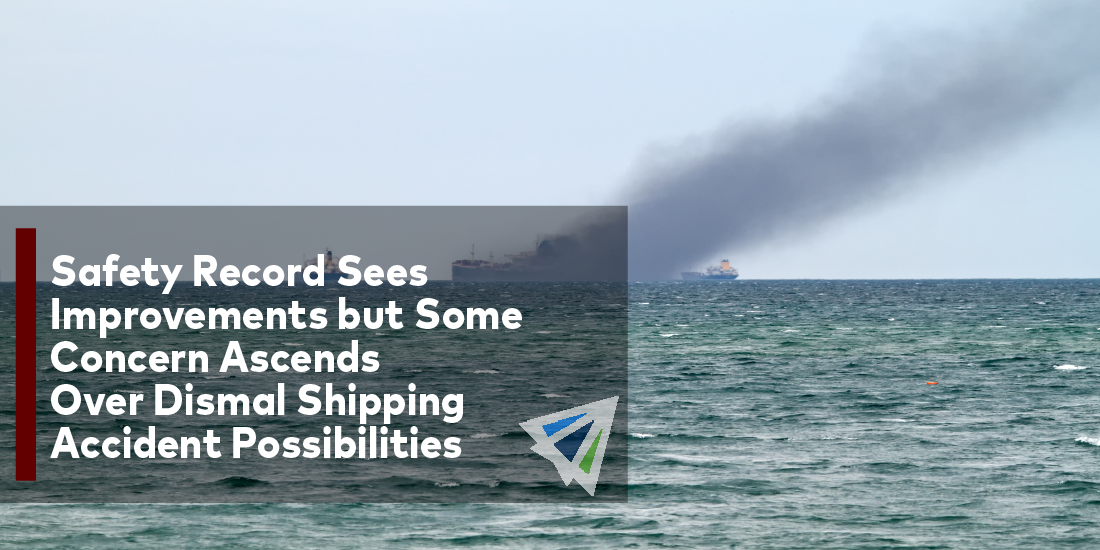Maritime safety is crucial especially with shipping transporting nearly 90 percent of the world’s trade on different vessels.
The safety record has seen improvements – in the sector reporting a record low number of large ships lost over the past year, at 38.
But, a combination of factors impacting fire risk, ongoing and new threats posed by global events, decarbonization challenges, economic uncertainty, and rising costs of marine claims, are all issues that still see the sector having to navigate throughout the next year and more.
Key Takeaways:
- Is there anything wrong with continuing to keep older ships in use?
- How decarbonization, economic uncertainty/global events, and rising costs of marine claims play a role in the increasing risk of fires at sea
- What does the future look like for the safety shipping record?
What Factors are Increasing the Risk of Fires at Sea?
In the last year, fire was the second top cause of loss with a total of 8 vessels lost and over 200 incidents were reported – highest in a decade.
Decarbonization
Right now, decarbonization is becoming quite popular, which leads to new types of cargo being transported on vessels, including electric vehicles and battery powered goods.
As well as flammable lithium-ion batteries which also pose a bigger risk to container shipping and car carriers. When fires occur in electric vehicles and lithium-ion batteries, it can become difficult to put out and has the capability to randomly reignite.
“Most ships lack the suitable protection, detection and firefighting capabilities to tackle such fires at sea,” Captain Rahul Khanna, Global Head of Marine Risk Consulting at AGCS stated.
Looking ahead into the next decade, the battery market is expected to grow by 30 percent, a report by Allianz Global shows. Even more reason to continue to improve the overall safety on ships.
Economic uncertainty/global events
As we are now in a post-pandemic boom, economic and geopolitical uncertainty and falling demand have caused a significant decrease in rates.
So how does that impact the safety on ships? Well as Justus Heinrich, Global Product Leader Marine Hull at AGCS says, that impact is yet to be determined.
“The question is whether this decline, together with the prospect of an economic downturn, will impact maintenance and risk management budgets. Prior downturns have impacted these, leading to losses and an uptick in machinery damage incidents.”
Rising costs of marine claims
Commodity price increases, higher labor costs and other supply chain disruptions all have played a part in the impact on marine insurance claims, specifically hull and machinery – AGCS notes.
“The price of steel, a key cost driver in hull claims, increased sharply post-pandemic, as did spare parts. A typical propeller or machinery claim now costs around two times more than pre-pandemic,” Regis Broudin, Global Head of Marine Claims at AGCS says.
Notably, shortages and delays in trying to retrieve replacement parts have also caused longer stays in repair yards. And on top of that, is the increased expense in dealing with large vessels that typically face higher costs for repairs, salvage and towing.
What’s Wrong with Older Ships?
There’s nothing wrong, per say, with older ships experts note. But the importance lies with how they were maintained during their life spans, as well as how they are currently being operated, crewed, maintained and insured.
Many of the older ships are operated by ocean carriers that do have high safety standards. For example, according to Freightwaves, MSC recently bought two 1999-built ships and CMA CGM continues to charter ships built 20 years ago.
Khanna notes that when rates were extremely high, some of the ships’ “lifespans” were extended more than typical, or even brought back to life.
“I think this takes time to translate into actual accidents and incidents. We should be thankful that the market has changed, and rates have come back to pre-pandemic levels and some of these ships will be taken out of the system [scrapped] this year or probably next year.”
Not to say that problems never will occur, because within time they will no matter how much maintenance and repairs you do.
Looking Ahead
Thirty years ago, the global fleet was losing 200+ vessels a year, a bleak outlook in comparison to what annual losses over the last ten years have looked like.
But of course, there’s more work to be done to improve the safety of ships.
“While these results are gratifying, several clouds appear on the horizon… fire safety and the problem of mis-declaration of hazardous cargo must be fixed if the industry is to benefit from the efficiency of ever-larger vessels,” Captain Rahul Khanna, Global Head of Marine Risk Consulting at AGCS stated on the outlook
Should you have any questions regarding this and how it could impact your shipments, please reach out to our team today.
Additionally, we have our weekly market updates that can provide you with relevant freight news, updates, developments across the industry, and more.
